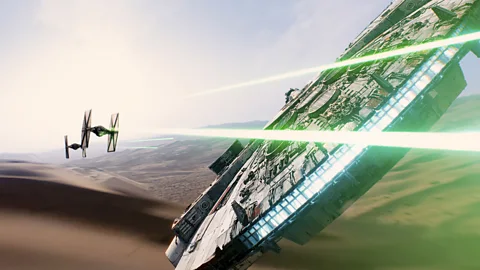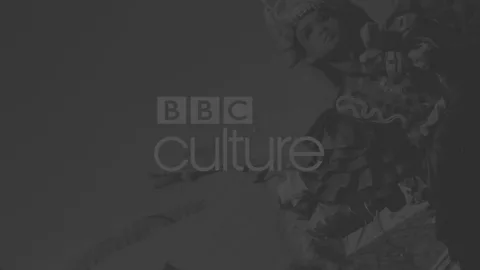Star Wars: The Force Awakens is 'a maddening almost-triumph'
 Disney/Lucasfilm
Disney/LucasfilmIt’s the most anticipated film in years and finally it is here. But can the new adventure set in that galaxy far, far away live up to the hype? Our critic Nicholas Barber has the answer.
If someone was remaking George Lucas’s Star Wars, and then they decided that they might as well stick in as much as they could from The Empire Strikes Back and Return of the Jedi while they were at it, the resulting film would be Star Wars: The Force Awakens. Directed by JJ Abrams, the most anticipated movie in the history of the universe has everything you from the original wondrous trilogy – and, oh all right, one or two echoes of the benighted prequels, too.
It’s not just a case of heroic Rebels (now called The Resistance) taking on the dastardly Empire (now called the First Order). It’s everything from the plucky youngster stuck on a desert planet to the loyal little droid embedded with a holographic message. It’s everything from the baddie in a black cape and mask to the bigger baddie with a withered white face. There is even a Death Star, for the third time in the series, which suggests that the villains bought a job lot of them, and are determined to keep using them however often they are demolished by X-Wing fighters.

With the reverence and enthusiasm of a boy playing with the world’s biggest collection of Star Wars toys, Abrams uses The Force Awakens to re-enact all of his favourite moments, with nothing much of his own to add except more roles for women, and more sympathy for the bad guys. But while it might have been nice to see some elements we weren’t familiar with already, Abrams inspires plenty of reverence and enthusiasm himself: his film, co-written by Lawrence Kasdan (who also co-wrote The Empire Strikes Back and Return of the Jedi), is truer to the swashbuckling Star Wars spirit than any of Lucas’s prequels.
It has the grimy, lived-in patina that distinguished the original trilogy; it has the balance between corny jokes and awe-inspiring scale; and it has, at its heart, the theme of all-for-one friendship that made us want to climb aboard the Millennium Falcon with Luke and Han. But it’s a pity that Abrams didn’t leave some of his toys in the box. When you stuff a trilogy’s worth of lightsaber duels, dogfights, revelations, deaths and victories into one film, they lose some of their – what’s the word? – force.
The plot is too convoluted to go into, but its key point is outlined in the first four words of the opening text crawl: Luke Skywalker has vanished. Yes, much like his mentors, Ben Kenobi and Yoda, Luke (Mark Hamill) is one of those annoyingly irresponsible Jedi Knights who exile themselves to remote planets just when the galaxy could really use their psychic powers. However, Princess Leia (Carrie Fisher) has learnt of a map that will lead her to her estranged brother (don’t ask how). The man to retrieve it is a daredevil Resistance pilot, Poe Dameron (Oscar Isaac), but the mission proves trickier than expected, and Poe’s robotic sidekick, the delightful BB-8, rolls into the hands of the film’s other two new heroes: a lonely scavenger, Rey (Daisy Ridley), and a reformed stormtrooper, Finn (John Boyega).
Jumping to lightspeed
The real star of this Star Wars episode is Harrison Ford, who still has all of Han Solo’s old rogueish-yet-hapless charm, plus an age-appropriate dollop of avuncular crotchetiness and wistful wisdom. But his successors are nearly as loveable. Isaac, having played so many flawed and desperate characters, shows that he can be a square-jawed matinee idol. Ridley is too posh to have grown up in a wilderness – she sounds as if she was the head girl at the same boarding school as Keira Knightley – but she has formidable energy, as well as being dazzlingly pretty. And Boyega gives the film’s undoubted breakthrough performance. Quite apart from mastering an American accent, the 23-year-old Londoner is expressive enough to make you laugh or gasp with the slightest frown.
The villains are impressive, too. Adam Driver, as the film’s Darth Vader-wannabe, Kylo Ren, conveys the torment of being torn between the Light and Dark Sides of the Force more affectingly in two scenes than Hayden Christensen did in two prequels, while Domhnall Gleeson brings a fascinating edge of fragility to his frothing fascist General Hux. He can command armies, but he looks as if he’d burst into tears if you slapped him.
As off-puttingly fresh-faced as these newcomers all are – and at times they resemble teenagers in home-made costumes at a science-fiction convention – they are worthy additions to the Star Wars universe, and it’s a silly-grinning pleasure to watch them racing down corridors and through asteroid fields. When The Force Awakens gets going, and Finn and Rey are dodging the agents of the First Order in what seems to be one, long, non-stop action sequence, you couldn’t ask for a more propulsive, joyous or witty Star Wars film. Abrams, you start to think, has delivered in style.
Somewhere around the halfway point, though, so many other characters muscle in that you begin to lose track of who is who and which planet they’re on. Explosion follows explosion, battle follows battle, and the scenario becomes so overcrowded that it’s a relief not to see Jar Jar Binks popping up. It’s exhausting. What the first Star Wars episode had was an archetypal fairy-tale structure: leave home, rescue princess, destroy enemies. In The Force Awakens, that clear structure is obscured by all the bits and pieces which it has imported from the sequels, and it ends up looking like a mess.
Ultimately, Abrams gives us too much and not enough, simultaneously, in that there is too much going on in The Force Awakens, but not enough of a satisfying story connecting it all together. A maddening almost-triumph, his film is less than the sum of its many, many parts. But, by George, some of those parts are glorious.
★★★★☆
